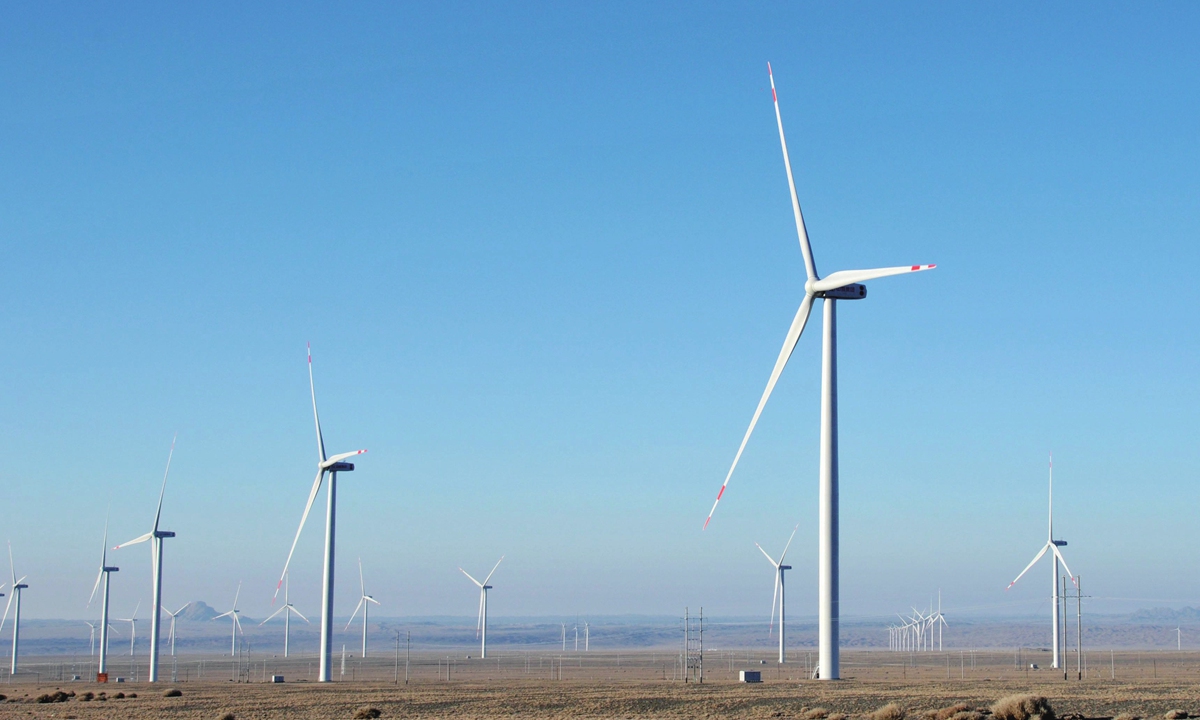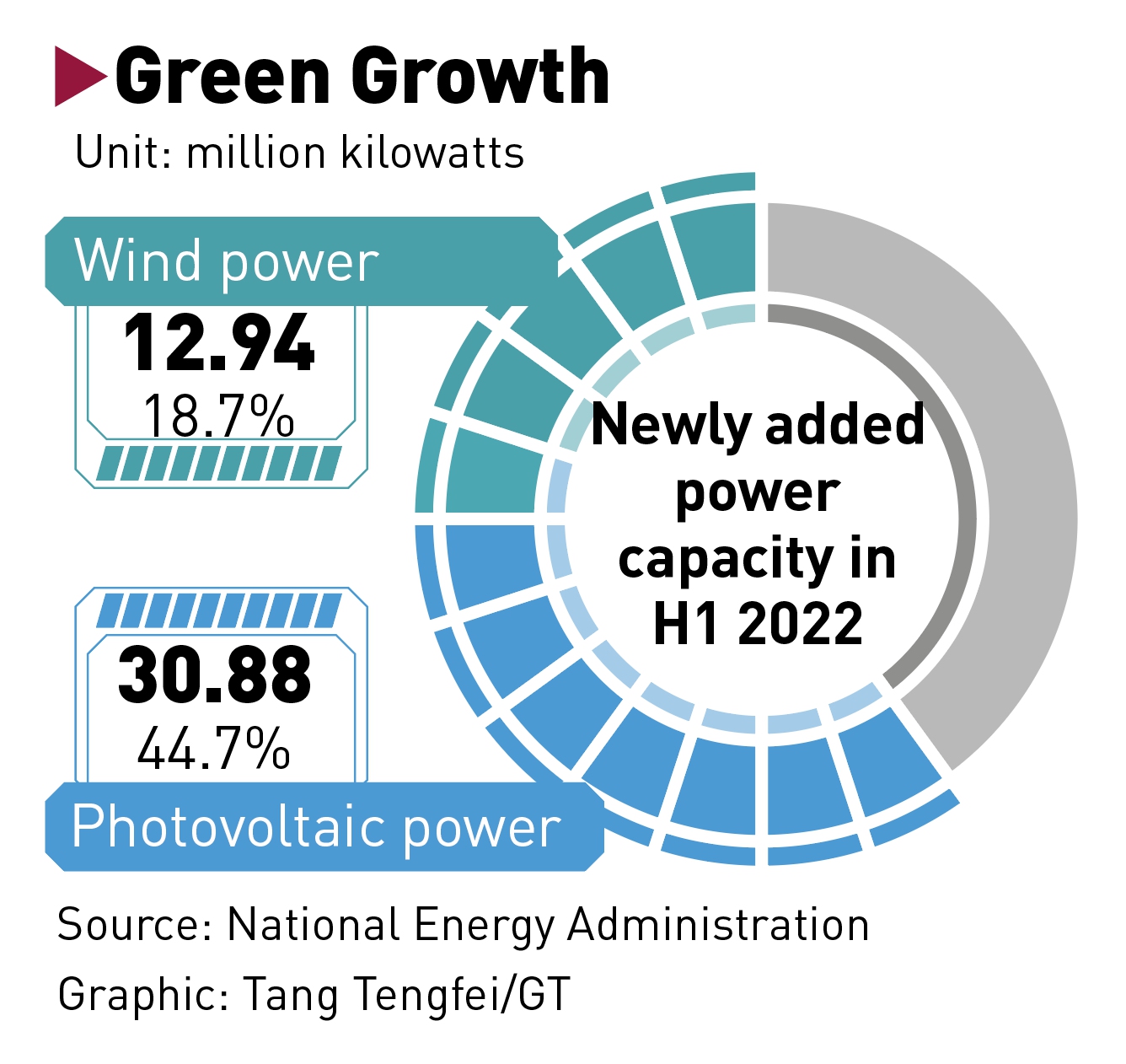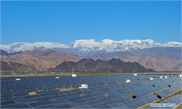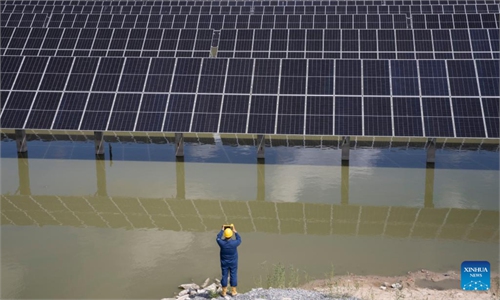
A view of wind turbines in Changji, Northwest China's Xinjiang Uygur Autonomous Region Photo: VCG
As construction of large-scale wind and photovoltaic power bases accelerates across the country, China's new-energy sector is expected to have greater growth potential this year amid the government's ramped-up efforts to achieve "dual carbon" goals.
In Urumqi, capital of northwest China's Xinjiang Uygur Autonomous Region, the construction of a wind power and photovoltaic base by China Huadian Corporation with a total installed capacity of 1 million kilowatts is now progressing in full swing.
The project, which is among the first batch of large-scale wind and photovoltaic power bases approved by the central government, is expected to generate 2.5 billion kilowatt-hours of green electricity while saving consumption of 830,000 tons of standard coal and reducing carbon dioxide emissions of 2.1 million tons after the project's completion.
All of the initial batches of such projects have thus far broken ground. The list of the second batch, which includes bases to be built in provinces and regions including Inner Mongolia, Ningxia, Xinjiang, Qinghai and Gansu, has been released.
Experts believe that the promotion of new-energy bases in China will significantly spur the development of the new-energy industry.
In the first half of 2022, China's installed capacity of wind and photovoltaic power added 12.94 million kilowatts and 30.88 million kilowatts, accounting for 18.7 percent and 44.7 percent of total new capacity, respectively, data from the National Energy Administration (NEA) showed.
'Dual carbon' goals
Driven by the country's "dual carbon" goals -- to achieve carbon peaking by 2030 and carbon neutrality by 2060, the new-energy sector has become one of the few industries that features a high utilization rate without generating excess capacity, said Jiang Debin, an expert with the China Electricity Council.
China's central government is promoting a range of green technologies such as wind turbines, solar panels, new-energy vehicles, green building construction, and many energy-saving products. A central role in the development of energy consumption in China is assigned to solar energy, which is expected to become the largest primary energy source by around 2045. The use of coal is planned to drop by 80 percent by 2060.
Su Xinyi, an analyst with China Electric Power Planning and Engineering Institute, noted that the new-energy sector will continue its fast expansion in the second half of 2022.
China's newly installed capacity of wind and photovoltaic power for the entire year is expected to exceed 100 million kilowatts, while the consumption of power produced by the two energy sources is estimated to reach over 12.2 percent of total power consumption, Su said.
In addition to boosting energy supply capacity, companies plan to double down on investments in projects including ultra-high voltage to improve the efficiency of new-energy consumption.
The State Grid Corporation of China intends to inject 2.4 trillion yuan ($354.53 billion) into the power grid during the 14th Five-Year Plan Period (2021-2025) to advance the building of a new-energy consumption system in the country.
China Southern Power Grid plans a fixed-asset investment of 125 billion yuan this year, which partly will be directed to building supporting power grid projects for new-energy transmission and pumped-storage hydroelectric projects.

Graphic: Tang Tengfei/GT
Rising utilization rate
Data from China Electric Power Planning & Engineering Institute showed China's new-energy sector has maintained a relatively high-level utilization efficiency in the first half of this year. As of the end of June, the nationwide utilization rate of wind power stood at 95.8 percent, while that of photovoltaic power was 97.7 percent.
According to a recent report by the International Energy Agency (IEA), the global manufacturing capacity for solar panels has increasingly moved out of Europe, Japan and the US over the last decade, and into China, which has taken the lead in investment and technology innovation.
China's share in all key manufacturing stages for solar panels exceeds 80 percent today, said the IEA report, and for key elements, including polysilicon and wafers, it is set to rise to more than 95 percent in the coming years.
The latest data from German research firm Bernreuter Research shows that seven of the world's top 10 largest polysilicon producers are based in China, with the others based in the US, Germany and South Korea.
Adjusting the energy structure is the key to reducing emissions, since energy is the main source of carbon emissions. China will focus on reducing emissions from industries such as iron and steel, non-ferrous metals, building materials, petrochemical and chemical, and urban and rural construction, and develop a circular economy, by promoting the comprehensive use and recycling of resources.



